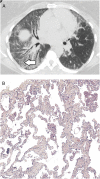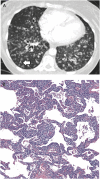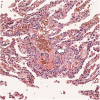Noninfectious pulmonary complications of human immunodeficiency virus infection
- PMID: 24992395
- PMCID: PMC4242118
- DOI: 10.1097/MAJ.0000000000000318
Noninfectious pulmonary complications of human immunodeficiency virus infection
Abstract
Human immunodeficiency virus type 1 (HIV-1) is the retrovirus responsible for the development of AIDS. Its profound impact on the immune system leaves the host vulnerable to a wide range of opportunistic infections not seen in individuals with a competent immune system. Pulmonary infections dominated the presentations in the early years of the epidemic, and infectious and noninfectious lung diseases remain the leading causes of morbidity and mortality in persons living with HIV despite the development of effective antiretroviral therapy. In addition to the long known immunosuppression and infection risks, it is becoming increasingly recognized that HIV promotes the risk of noninfectious pulmonary diseases through a number of different mechanisms, including direct tissue toxicity by HIV-related viral proteins and the secondary effects of coinfections. Diseases of the airways, lung parenchyma and the pulmonary vasculature, as well as pulmonary malignancies, are either more frequent in persons living with HIV or have atypical presentations. As the pulmonary infectious complications of HIV are generally well known and have been reviewed extensively, this review will focus on the breadth of noninfectious pulmonary diseases that occur in HIV-infected individuals as these may be more difficult to recognize by general medical physicians and subspecialists caring for this large and uniquely vulnerable population.
Conflict of interest statement
The authors have no financial or other conflicts of interest to disclose.
Figures




References
-
- Lohse N, Hansen AB, Pedersen G, et al. Survival of persons with and without HIV infection in Denmark, 1995-2005. Ann Intern Med 2007;146:87–95. - PubMed
-
- Akinbami LJ, Moorman JE, Bailey C, et al. Trends in asthma prevalence, health care use, and mortality in the United States, 2001-2010. NCHS Data Brief No. 94 May 2012;1–8. - PubMed
-
- Poirier CD, Inhaber N, Lalonde RG, et al. Prevalence of bronchial hyperresponsiveness among HIV-infected men. Am J Respir Crit Care Med 2001;164:542–5. - PubMed
-
- Wallace JM, Stone GS, Browdy BL, et al. Nonspecific airway hyperresponsiveness in HIV disease. Pulmonary Complications of HIV Infection Study Group. Chest 1997;111:121–7. - PubMed
Publication types
MeSH terms
Grants and funding
LinkOut - more resources
Full Text Sources
Other Literature Sources
Medical
Research Materials

